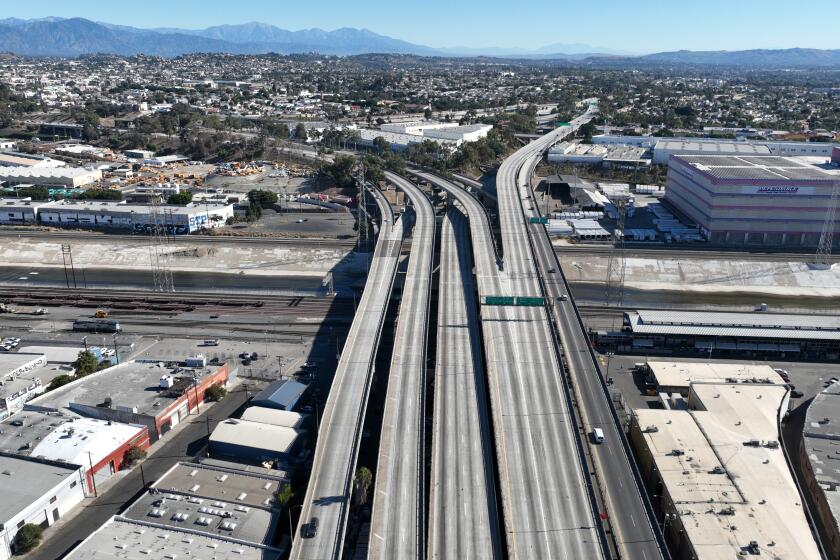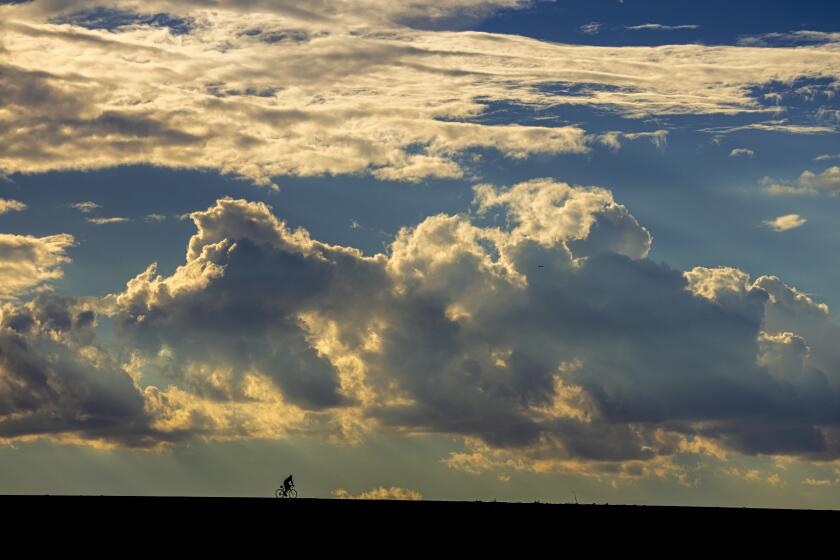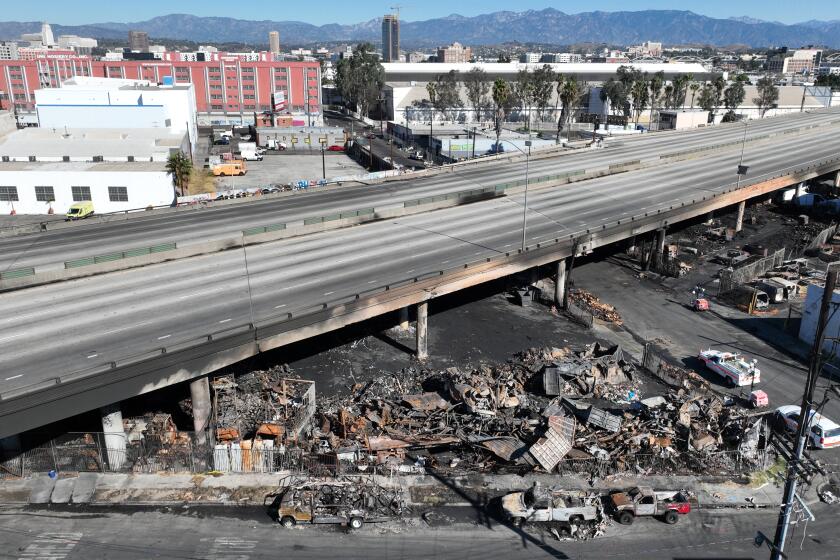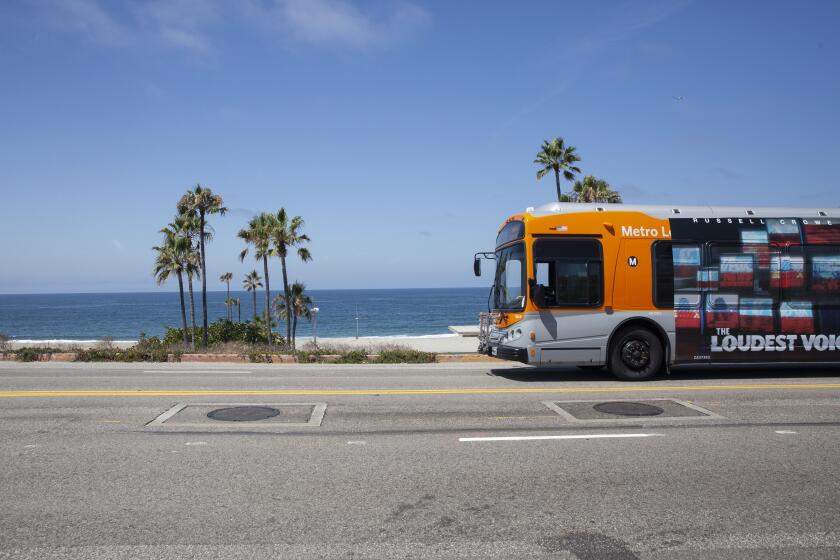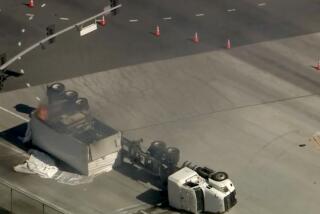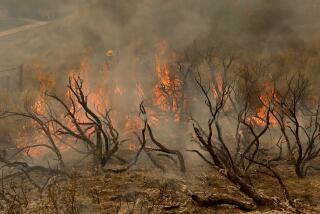Arson is behind the massive fire that shut down the 10 Freeway, officials say
(Robert Gauthier / Los Angeles Times)
The massive fire that has shut down a crucial section of the 10 Freeway in downtown Los Angeles was caused by arson, officials said Monday as they raced to assess the extent of the damage and determine how long it would take to reopen.
More than 100 columns along the swath of the freeway were damaged — nine or 10 of them severely — Gov. Gavin Newsom said.
It’s still unclear, pending the results of official tests at the site, if the entire overpass will be torn down or retrofitted.
The situation poses a commuting challenge that L.A. has not seen in years, with hundreds of thousands of commuters facing detours and heavier-than-normal traffic. Starting Monday, some worked from home and others took mass transit, but many simply endured the delays.
The closure caused gridlock in some areas, but there was general sentiment that L.A. survived the first morning and evening commute without too much chaos thanks in part to warnings sent to residents’ cellphones.
The fire began under the overpass at Alameda Street early Saturday morning, fueled by wood pallets stored there.
Although the exact cause of the fire has not been revealed, “there was [malicious] intent,” Newsom said at a news conference Monday afternoon.
In addition to pallets, sanitizer accumulated during the height of the COVID-19 pandemic was stored under the overpass and helped fuel the flames, according to sources familiar with the probe who were not authorized to discuss details of the investigation.
A crucial stretch of the 10 Freeway remains closed through downtown L.A. after a major fire damaged the highway. Here is what we know.
State Fire Marshal Daniel Berlant appealed for witnesses to call a tip line with information and noted those tips could be given anonymously.
“We have identified the point of origin of the fire,” Berlant said. He would not provide further detail, saying the investigation was ongoing. Berlant said investigators had dug through the rubble for evidence and canvassed the neighborhood for witnesses.
Officials said the property where the fire broke out was being leased by Calabasas-based Apex Development Inc., which was subleasing the storage site under the overpass without permission from state and federal agencies. The company stopped paying rent, according to Newsom, and had been out of compliance with its lease agreement.
Federal, state and local agencies are scrambling to determine what happens next after the sudden closure of the mile-long section of the heavily trafficked freeway between Alameda Street and the East L.A interchange, a key east-west route through downtown. Mayor Karen Bass said that U.S. Secretary of Transportation Pete Buttigieg called and reassured her that federal officials were aware of the impact from closing one of the busiest freeway corridors in the country.
“Losing the stretch of the 10 Freeway will take time and money from people’s lives and businesses,” Bass said. “It’s disrupting in every way. Whether you were talking about traveling to and from work, or your child care plans, and the flow of goods and commerce, this will disrupt the lives of Angelenos.”
Mitigation of hazardous materials at the site is ongoing, but most of the site has been cleared for structural engineers and maintenance crews to start their work, California Transportation Secretary Toks Omishakin said. They have taken samples of the freeway columns and bridge deck.
An initial influx of federal emergency funds has been secured, said Tony Tavares, director of the California Department of Transportation. Contractors have installed shoring underneath the overpass and in the most heavily damaged areas. Video footage from the scene shows the charred underbelly of the overpass and what appear to be sections of columns chipped away.
The fire was reported early Saturday, shortly after midnight, in the 1700 block of East 14th Street after a pallet yard under the freeway caught fire and spread to a second pallet yard, damaging the freeway overpass and destroying several vehicles, including a firetruck, authorities said.
Timothy Garrison, 55, was sleeping behind a nearby Shell gas station near the overpass when he heard explosions, he said Monday morning as he sat against a wall near 14th and Elwood streets, around the corner from the site of the fire.
When he peeked out of his makeshift tent made of plastic trash bags, he saw giant flames flickering out of the overpass.
“The heat was so intense,” he said. “I thought the overpass was going to crumble.”
Garrison heard about 10 to 15 pops and explosions as the fire continued to rage, and he moved to escape the heat, he said.
He knew of some people who lived underneath the freeway but said he had not seen them.
Bass said 16 people were living in the encampment, and all had been moved into hotels and motels.
A row of blue tarps, trailers and wooden shacks sat along 14th Street on Monday among piles of wood from pallets and metal debris. Wooden pallet yards are common along the 10 Freeway in the industrial center near downtown.
Not far from Santa Clara Street, a group of men had set cardboard and wood on fire to cook several feet from a pallet yard.
CalFire officials said they were taking all elements into consideration in their investigation, including the presence of homeless people in the area. But on Monday afternoon, Bass said there was “no reason to assume the reason this fire happened was because there were unhoused individuals nearby.”
Showers expected to begin Wednesday will bring 1 to 3 inches of rain to Southern California over four days, without intense storms or flooding, forecasters say.
Workers in the area said firefighters frequently come to put out fires caused by people living on the streets.
It’s why Antolín Padilla, 34, installed fire extinguishers at the entrances of his business Jaz Pallets, which sits along the railroad tracks near Santa Clara Street. He and another pallet yard owner on 14th Street agreed to enforce a “no camping zone” around their businesses, often telling people to camp elsewhere, after a fire spread to the wall of Padilla’s pallet yard a few months ago.
“The workers grabbed the extinguishers in time and were able to put it out,” he said, pointing to a charred corner of the wall. “The city needs to move people from this area.”
Nearby, David Cortez, 34, owner of D&G Pallets, said the fire shows why he’s often on edge.
Standing outside his business, he pointed to a pole where a thin green wire dangled from the power line above, saying he worried about homeless people tampering with lines to tap into the electricity.
“I’m not even sure if that wire is energized or not, but it’s dangerous,” he said. “And the fire hydrants have been damaged from people attempting to use pliers to get water.”
Derrick Smith, 39, walked nearby pushing a cart filled with metal debris. He had been staying near the overpass when the fire broke out. At least five or six people were living around him, he said.
Smith said he was in a deep sleep when he started to hear people banging on his trailer to warn him of the fire.
“They kept saying there’s a fire and get out,” he said. He ran away, leaving all his belongs behind.
“The heat was intense as hell,” he said.
Wearing a blue hoodie, black shorts and dirty Crocs, he said he had no change of clothes and is not sure whether he lost his trailer.
“I probably did,” he said, stuffing his hands in the pockets of his sweater.
Monday’s commute was the first weekday for Angelenos encountering the disruption. The mayor’s office sent an emergency advisory Sunday evening alerting residents about the detour, and officials encouraged employers to let their employees work remotely if possible. Nearby L.A. Unified schools remained open, though traffic was expected to be worse, especially in Boyle Heights and south of downtown.
At Grand Central Market, Maria Behringer scrambled Monday to set up the pastries for Bastion Bakery after she left her apartment near USC around 6:40 a.m. and arrived around 7:15 a.m. Though the market opens at 8 a.m., she needed time to set up her station before customers started trickling in.
“I was definitely rushing more than I usually do, so it was little a bit of a stressor,” said Behringer, 30. “I didn’t realize how close the fire was to downtown and I didn’t realize it would affect my commute.”
Her partner, Brandon Walsh, who rode in with her, said their usual commute takes them east on the 10 and then onto the 110 Freeway. But this time, the GPS rerouted them to side streets.
“I think so much was diverted to 110 [because of the fire] so the GPS just told us to get off at Grand and go into the city,” said Walsh, 32.
Officials encouraged car commuters to try alternatives, such as Metrolink, rail lines and local bus services, which are all expecting an increase in daily riders.
Metro Chief Executive Stephanie Wiggins told Angelenos to “plan ahead, share the ride, and keep up to date” on the disruption. She said there was a noticeable increase in cars parked at Union Station on Sunday, indicating people are taking advantage of public transportation. Officials directed drivers to check the detour status online at emergency.lacity.gov, and commuters can call 511 or check Metro.net for alternative routes.
Investigators are looking into the cause of a major fire that has shut down the 10 Freeway in downtown L.A. Officials said to expect ‘significant’ traffic issues.
“This is our litmus test,” Omishakin said Monday. “Did we reach everyone and convince them that they need to plan ahead and plan alternate routes?”
At Union Station, Metro ambassadors said foot traffic was lighter than usual.
Brian Lin, 45, of Anaheim was sitting in heavy traffic on the 5 Freeway when he decided to park his car at Atlantic station in East Los Angeles and take the train into Union Station.
He admitted he doesn’t typically take the train to work, but Monday’s congestion called for a change — at least for one day.
“Luckily, it was just a quick meeting that I had to do in the office,” Lin said before an incoming Metro train chimed in the distance. “I think my ride is here.”
Claire Stolwyk, 27, waited for the J line bus at the Civic Center/Grand Park station while reading a book when she realized she had forgotten to check whether her commute to Cal State L.A. would be affected.
She pulled out her phone and saw a notice from Metro on Google Maps, but it looked like her route was in the clear. The bus pulled up to the stop on time.
Twenty-five participants in a journalism fellowship in L.A. used Metro buses and trains to get to multiple meetings a day for a week. Safely. Happily. And on time.
Showers expected to begin Wednesday will bring 1 to 3 inches of rain to Southern California over four days, without intense storms or flooding, forecasters say.
More to Read
Sign up for Essential California
The most important California stories and recommendations in your inbox every morning.
You may occasionally receive promotional content from the Los Angeles Times.
